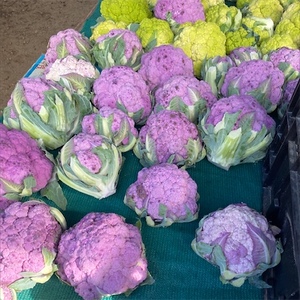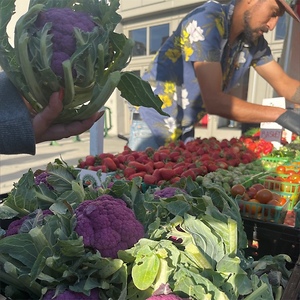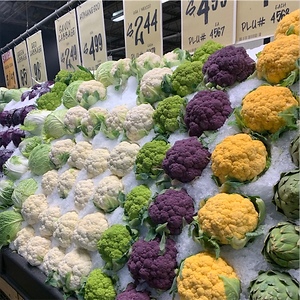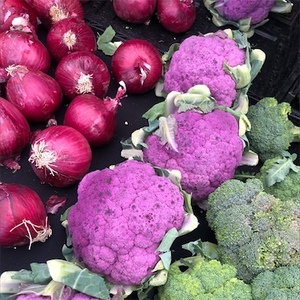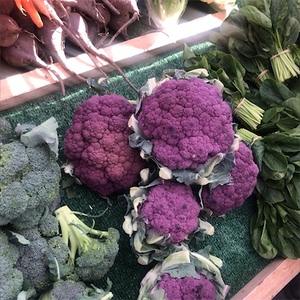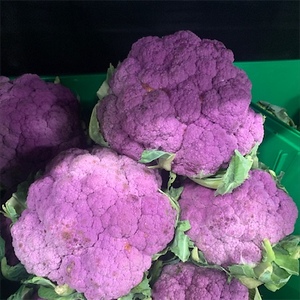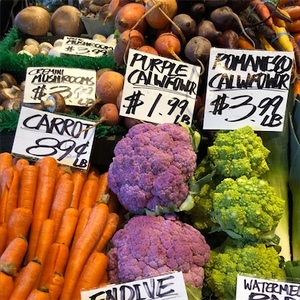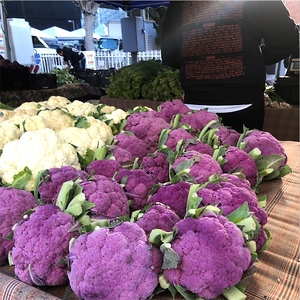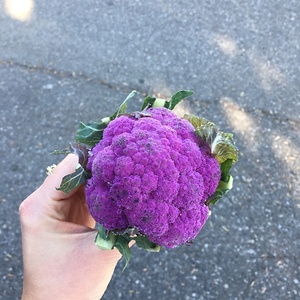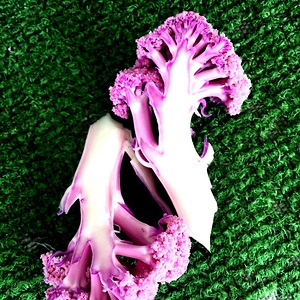


Baby Purple Cauliflower
Estimated Inventory, 24 ct : 0
Description/Taste
Baby Purple cauliflower is a smaller, violet-colored variation of the traditional cauliflower. The head of this variety measures 10 to 15 centimeters across, and, including the stem, can reach up to about 20 centimeters in height. It resembles a miniature tree, with densely packed florets clustered at its head, supported by a short and stout stem. The head of the vegetable has a vibrant purple hue with a white stem that transitions to light lavender as it nears the florets. Light green leaves at the base of the stem wrap around part of its head and are often removed when eaten. The head feels bumpy to the touch due to its condensed florets, while the stem is smooth yet sturdy, making it hard to cut. Baby Purple cauliflower emits a mild, earthy, and slightly sweet aroma. The flavor of Baby Purple cauliflower is milder, sweeter, nuttier, and free of the bitterness sometimes associated with larger varieties of Purple cauliflower.
Seasons/Availability
Baby Purple cauliflower's peak season is during the fall and winter months.
Current Facts
Baby Purple cauliflower is a cool-season, biennial cruciferous vegetable with the botanical name Brassica oleracea var. Botrytis. It belongs to the Brassicaceae family. Unlike traditional cauliflower, which is bred to grow without any natural pigment, modern cultivation has introduced vibrant green, orange, and purple varieties. The distinctive hue of Baby Purple cauliflowers results from the presence of anthocyanin, an antioxidant also found in red cabbage and red wine. Several types of Purple cauliflower exist, including Sicilian Violet, Violet Queen, Rambo Purple, Purple Cape, and Graffiti. When cultivating Baby Purple cauliflower, blanching — the process of covering the head to shield it from sunlight — is unnecessary. Sunlight enhances the color of the curds, contributing to the development of their distinctive and vibrant tone.
Nutritional Value
Baby Purple cauliflower shares many of the same nutrients as its fully-grown counterpart, though the concentration of certain nutrients can slightly differ due to variations in maturity. Younger plants may boast marginally higher levels of specific vitamins and antioxidants, although these differences are usually minimal. Baby Purple cauliflower is an excellent source of dietary fiber, essential for maintaining healthy digestion. It contains a higher amount of vitamin A compared to traditional white cauliflower. The antioxidant anthocyanin that gives the vegetable its purple color plays an important role in combating oxidative stress and inflammation. This antioxidant may reduce the risk of chronic diseases such as cancer, heart disease, and diabetes. Anthocyanins may also help regulate blood pressure, enhance vascular function, and exhibit antimicrobial effects that could potentially shield the skin from UV damage. Baby Purple cauliflower contains folate, calcium, potassium, and selenium, which support cellular, bone, dental, muscular, and immune health.
Applications
Baby Purple cauliflower can be steamed, roasted, grilled, or eaten raw. When cooked, it often reveals brighter shades of purple while intriguingly turning cooking water green. As a raw ingredient, it can be used in a crudité platter and finely chopped or riced in salads. Its petite florets are more manageable than those of larger varieties, making them an ideal addition to pizzas, pastas, gratins, frittatas, and quiches. Beyond these methods, Baby Purple cauliflower can be transformed into a smooth puree, pickled in a jar, or combined with other purple vegetables like radicchio, cabbage, eggplant, and beets for a monochromatic dish. This vegetable pairs well with a wide array of ingredients including broccoli, green beans, peas, chicken, fish, pork, asparagus, potatoes, and wild rice. It also complements onions, almonds, sesame seeds, and soft cheeses such as goat cheese, feta, and Parmesan. The flavors are further enriched with spices like cumin, coriander, turmeric, tahini, and smoked paprika, as well as herbs like rosemary, dill, and parsley. For storage, it is best kept in a perforated plastic bag in the refrigerator's crisper drawer, washing only just before use.
Ethnic/Cultural Info
Despite its abnormal color, Baby Purple cauliflower is neither genetically modified nor artificially colored, contributing to its popularity among health food enthusiasts. It has gained favor with health-conscious consumers and farm-to-table restaurants alike. Purple Cauliflower enjoys particular popularity in countries like the United Kingdom, Italy, and France, where the environmental advantages of crop diversification are highly valued. Its numerous health benefits also make Baby Purple cauliflower a good choice for baby foods. There are many recipes for infants featuring puréed Purple cauliflower due to its gentle impact on a baby's developing digestive system, its sweet and mild flavor that suits infant palates without overwhelming them, and its low allergenic potential.
Geography/History
Baby Purple cauliflower, like all cauliflower varieties, descends from the wild cabbage indigenous to the Mediterranean and Asia Minor. Although the precise ancestry of Baby Purple cauliflower remains uncertain, one heirloom variety traces its roots to Sicily while another hails from South Africa. It’s known for thriving in the exposed, harsh conditions of Western Europe. Though it prefers cool climates, Baby Purple cauliflower requires a sunny location with well-drained, fertile soil for optimal growth. Unlike its wild ancestors, Baby Purple cauliflower is a result of careful cultivation that focuses on its size, color, and nutritional benefits. It emerged from a mutant plant discovered in the late eighties, gradually gaining popularity alongside other colorful cauliflower variants. Due to its specialty nature and the extra labor involved in cultivation and harvest, Baby Purple cauliflower may be less available and more costly than its larger purple counterparts. However, it can still be found in farmers' markets and health-conscious grocery stores, catering to those seeking unique and nutritious produce.
Recipe Ideas
Recipes that include Baby Purple Cauliflower. One
Podcasts



